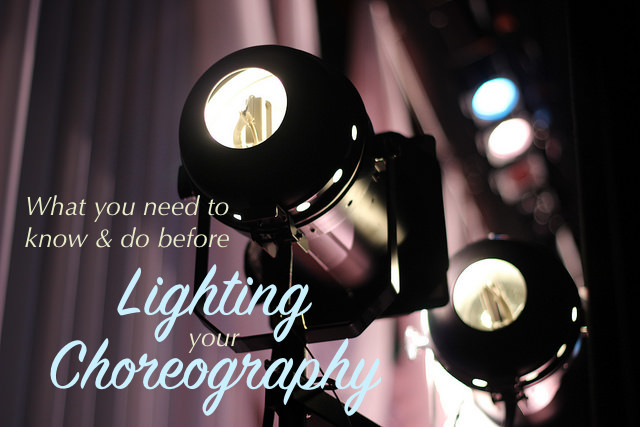Lighting design is an essential part of choreography because it allows the choreographer to control how the audience sees and experiences a work. Despite this, it is easy for choreographers to ignore this aspect: leaving the design to the tech crew. In particular, younger choreographers tend to shy away from lighting design because they simply don’t know anything about it.
However, a choreographer does not need to be an expert in lighting design to create an effective concept for his/her work. The process of lighting design is necessarily a collaborative effort between the choreographer and the theater’s lighting designer. With a cursory knowledge of the concepts discussed below, the choreographer can enhance his/her work through creating lighting design that compliments the choreography.

Know Your Objective
The primary objective of lighting is visibility. What do you want your audience to see? For example, to emphasize a soloist, a choreographer my chose to light her with a single pool of down light (a circle of light surrounding a dancer) with the remainder of the stage dark. Most theaters have at least nine pools of down light, arranged in a grid.
It is also possible to light a path (a strip of light running from upstage to downstage), a plane (a strip of light running from stage left to stage right), or a diagonal (a strip of light running from downstage left to upstage right, or visa versa). These various strips of light can emphasize dancers where they are in a corresponding formation.
In addition to being used to emphasize an element of a work you want the audience to see, these lighting techniques can also be used to hide an element of the work you do not want the audience to see. Lighting is often used to hide formation changes, entrances, and exists. For example, while a dancer is lit in a pool of down light, other dancers can change formation unseen in the surrounding dark area.
Select Your Backdrop
Most often, a choreographer will have two options for the curtain that hangs in the back of the stage.
The first option, a cyc, is a white curtain that can be lit with many different colors. Choreographers should select a cyc where they want their piece to be brightly lit and colorful. The lighting scheme on the cyc can change throughout the piece.
The second option, a traveler, is a black curtain. When the traveler is down, the lighting will necessarily be darker than with a cyc. Use of the traveler creates a more natural effect, and is often used with white lights from above (down lights) and from the side (side lights).
Consider Color
If you decide to use colored light, consider what colors will compliment your work. Consider the color of your costumes, and what mood you would like to strike with the audience. In general, warm colors (yellow, red, and orange) can be used to evoke feelings of excitement, warmth, and even anger. In contrast, cool colors (blue, green, and purple) are considered to be more soothing, and can evoke feelings of sadness or romance.
Be Prepared
There is never enough time for tech rehearsals. When you arrive at the lighting booth, it is vital to have your lighting cues prepared.
The first cue you will be asked for is the order of sound and light (i.e. when does the music begin in relation to the lights turning on). These may occur simultaneously, or one after the other.
Number the remainder of your cues, and note the place in the music that each cue should occur (for example, Cue 2 – 1:32). For each cue, write in plain terms what you want. Write your cues in clear, unambiguous language. Use stage directions (i.e. stage left, stage right, downstage, upstage).
While this is by no means a complete guide to lighting design, I hope that these tips aid and encourage young choreographers to tackle this important aspect of choreography. When lighting design is brought the forefront of the choreographic process, it allows the choreographer to present a truly finished work.
More on Lighting Dance
The following books and resources include more information and tips on lighting design for dance. Continue to educate yourself whether you are a new or seasoned choreographer.

An Introduction to Dance Lighting at On Stage Lighting
Stage Lighting Basics at On Stage Lighting (lots of links!)
Stage Lighting for Students at stagelightingprimer.com
Glossary of Theatrical Lighting Terminology
Chelsey Bradley is a choreographer, professor, and author. She completed her Master’s Degree in Dance and Choreography in 2017 from the Peck School of the Arts, and then served as a lecturer of dance for the University of Wisconsin, Eau Claire. She currently serves as resident choreographer for Dance Wisconsin, and teaches modern dance for Monona Academy of Dance. Her work for these companies has earned her Regional Dance America’s National Choreographic Commissioning award four times, Regional Dance America’s Choreography Connection Grant in 2014, and a Choreographic Honors Award from the University of Wisconsin, Madison, in 2015. Read Chelsey’s posts.


